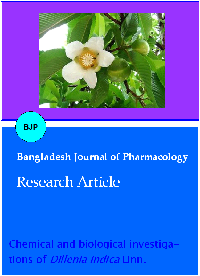Chemical and biological investigations of Dillenia indica Linn.
DOI:
https://doi.org/10.3329/bjp.v4i2.2758Keywords:
Antimicrobial, Antioxidant, Cytotoxicity, Dillenia indica,Abstract
A total of four compounds namely, lupeol (1), betulinaldehyde (2), betulinic acid (3) and stigmasterol (4) were isolated from the stem extract of Dillenia indica Linn. The structures of the isolated compounds (1-4) were established by extensive spectroscopic studies. The crude methanolic extracts and its n-hexane, carbon tetrachloride, dichloromethane and chloroform soluble partitionates demonstrated weak antimicrobial activity against a wide range of Gram-positive and Gram-negative bacteria and fungi. The extractives revealed significant cytotoxic activity when tested by brine shrimp lethality bioassay. In addition, the extractives exhibited significant free radical scavenging activity when compared with the standard drug ascorbic acid.
Downloads
354
505 Read
43
References
Aratanechemuge Y, Hibasami H, Sanpin K, Katsuzaki H, Kunio I K, Komiya T. Induction of apoptosis by lupeol isolated from mokumen (Gossampinus malabarica L. Merr) in human promyelotic leukemia HL-60 cells. Oncol Rep. 2004; 11: 289-92.
Banerji N, Majumbder P, Dutta NI. A new pentacyclic triterpene lactone from Dillenia indica. Phytochemistry 1975; 14: 1447-48.
Bhattacharyya J, Barros CB. Triterpenoids of Cnidosculus urens. Phytochemistry 1985; 25: 274-76.
Brand-Williams W, Cuvelier ME, Berset C. Use of a free radical method to evaluate antioxidant activity. Lebensm. Wiss. Technol. 1995; 28: 25-30.
Eloff JN, Katerere DR, McGaw LJ. The biological activity and chemistry of the southern African Combretaceae. J Ethnopharmacol. 2008; 119: 686-99.
F. M. Maniruzzaman, Udvid Samhita (A compendium of plants in Bangladesh). 1st ed. Dhaka, Bangla Academy, 1993, p 270.
Ikuta A, Itokawa H. Triterpenoids of Paeonia japonica callus tissue. Phytochemistry 1988; 27; 2813-15.
Panda S, Jafri M, Kar A, Meheta BK, Thyroid inhibitory, antiperoxidative and hypoglycemic effects of stigmasterol isolated from Butea monosperma. Fitoterapia 2009; 80: 123-26.
Pavanasasivam G, Sultanbawa MUS. Chemical investigation of ceylonese plants. Part XII. (+)-3,4,5,7-Tetrahydroxy-3-methoxyflavanone [(+)-dihydroisorhamnetin] and 3,5,7-trihydroxy-3,4-dimethoxyflavone (dillenetin): Two new natural products from Dillenia indica L. J Chem Soc Perkin Trans. 1 1975; 6: 612-13.
Radovanovic A, Radovanovic BB, Jovancicevic B. Free radical scavenging and antibacterial activities of southern Serbian red wines. Food Chem. 2009; 117: 326-31.
Zhong S, Waterman PG, Jeffreys JAD. Naphthoquinones and triterpenes from African Diospyros species. Phytochemistry 1984; 23: 1067-72.

Additional Files
Published
How to Cite
Issue
Section
License
Authors who publish with this journal agree to the following terms:
- Authors retain copyright and grant the journal right of first publication with the work simultaneously licensed under a Creative Commons Attribution License that allows others to share the work with an acknowledgement of the work's authorship and initial publication in this journal.
- Authors are able to enter into separate, additional contractual arrangements for the non-exclusive distribution of the journal's published version of the work (e.g., post it to an institutional repository or publish it in a book), with an acknowledgement of its initial publication in this journal.
- Authors are permitted and encouraged to post their work online (e.g., in institutional repositories or on their website) prior to and during the submission process, as it can lead to productive exchanges, as well as earlier and greater citation of published work (See The Effect of Open Access).
